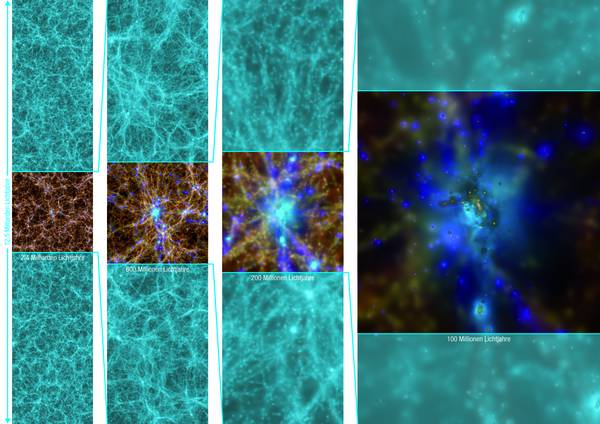Magneticum Pathfinder: The evolution of the universe in an unmatched precision
21.10.2015 —
The world's most elaborate cosmological simulation of the evolution of our universe was accomplished by theoretical astrophysicists of the Ludwig-Maximilians-Universität München (LMU) in cooperation with experts of the Excellence Cluster Universe’ datacentre C2PAP and of the Leibniz Supercomputing Centre. The most comprehensive simulation within the "Magneticum Pathfinder" project pursues the development of a record number of 180 billion tiny spatial elements in a previously unreached spatial area of 12.5 billion light years. For the first time, a hydrodynamic cosmological simulation is large enough to be directly compared with large-scale astronomical surveys.
Within modern cosmology, the Big Bang marks the beginning of the universe and the creation of matter, space and time about 13.8 billion years ago. Since then, the visible structures of the cosmos have developed: billions of galaxies which bind gas, dust, stars and planets with gravity and host supermassive black holes in their centres. But how could these visible structures have formed from the universe’s initial conditions?
To answer this question, theoretical astrophysicists carry out cosmological simulations. They transform their knowledge about the physical processes forming our universe into mathematical models and simulate the evolution of our universe on high-performance computers over billions of years.
A group of theoretical astrophysicists from the LMU led by Klaus Dolag has now, as part of the Magneticum Pathfinder project, performed a new, unique hydrodynamic simulation of the large-scale distribution of the universe’s visible matter. The most recent results regarding the three most important cosmic ingredients of the universe are taken into account – the dark energy, the dark matter and the visible matter.
The scientists incorporated a variety of physical processes in the calculations, including three that are considered particularly important for the development of the visible universe: first, the condensation of matter into stars, second, their further evolution when the surrounding matter is heated by stellar winds and supernova explosions and enriched with chemical elements, and third, the feedback of supermassive black holes that eject massive amounts of energy into the universe.
The most comprehensive simulation covers the spatial area of a cube with a box size of 12.5 billion light years. This tremendous large section of the universe was never part of a simulation before. It was divided into a previously unattained number of 180 billion resolution elements, each representing the detailed properties of the universe and containing about 500 bytes of information.
For the first time, these numerous characteristics make it possible to compare a cosmological simulation in detail with large-scale astronomical surveys. "Astronomical surveys from space telescopes like Planck or Hubble observe a large segment of the visible universe while sophisticated simulations so far could only model very small parts of the universe, making a direct comparison virtually impossible," says Klaus Dolag. "Thus, Magneticum Pathfinder marks the beginning of a new era in computer-based cosmology."
This achievement is preceded by ten years of research and development, accompanied by experts of the Leibniz Supercomputing Centre (LRZ) of the Bavarian Academy of Sciences, one of the most powerful scientific computer centres in Europe. "One of the biggest challenge for such a complex problem is to find the right balance between optimizing the simulation code and the development of the astrophysical modelling," explains Klaus Dolag. "While the code permanently needs to be adjusted to changing technologies and new hardware, the underlying models need to be improved by including better or additional descriptions of the physical processes which form our visible universe."
The realization of this largest simulation within the Magneticum Pathfinder project took about two years. The research group of Klaus Dolag was supported by the physicists of the datacentre C2PAP which is operated by the Excellence Cluster Universe and located at the LRZ. Within the framework of several one-week workshops, the Magneticum Pathfinder team got the opportunity to use the LRZ’ entire highest-performance supercomputer SuperMUC for its simulation. "I do not know any datacentre that would have allowed me to use the entire computing capacity for such a long time," says Klaus Dolag.
Overall, the Magneticum Pathfinder simulation utilised all 86,016 computing cores and the complete usable main memory – 155 out of a total of 194 terabytes – of the expansion stage "Phase 2" of the SuperMUC which was put into operation recently. The entire simulation required 25 million CPU hours and generated 320 terabytes of scientific data.
These data are now available for interested researchers worldwide. The Munich-based astrophysicists are already engaged in further projects: Among others, Klaus Dolag is currently collaborating with scientists from the Planck collaboration to compare observations of the Planck satellite with the calculations of Magneticum Pathfinder.
Acknowledgement
The extensive development work for the hydrodynamic simulations of the Magneticum Pathfinder project was in particular supported by the Bavarian Competence Network for Technical and Scientific High Performance Computing (KONWIHR), the Astrolab at the LRZ and the Excellence Cluster Universe with its datacentre C2PAP.
Further information
www.magneticum.org
Further picture material and video footage on request
Original publication Magneticum Pathfinder
Dolag, Gaensler, Beck & Beck: Constraints on the distribution and energetics of fast radio bursts using cosmological hydrodynamic simulations, 2015, MNRAS 451,4277, arXiv: 1412.4829
Teklu, Remus & Dolag et al.: Connecting Angular Momentum and Galactic Dynamics: The complex Interplay between Spin, Mass, and Morphology, The Astrophysical Journal 2015, (in press), arxiv:1503.03501
Remus, Dolag & Bachmann et al.: Disk Galaxies in the Magneticum Pathfinder Simu-lations, 2015, International Astronomical Union Symposium, Volume 309,145-148
Dolag, Komatsu & Sunyaev: SZ effects in the Magneticum Pathfinder Simulation: Comparison with the Planck, SPT, and ACT results, 2015, arXiv:1509.05134
Bocquet, Saro, Dolag & Mohr: Baryon impact on the halo mass function: Fitting formulae and implications for cluster cosmology, 2015, arXiv:1502.07357
Contact
PD Dr. Klaus Dolag
Ludwig-Maximilians-Universität München
Universitäts-Sternwarte München
Scheinerstr. 1
D-81679 München
Tel. +49 89 2180 5994
E-Mail: dolag@usm.lmu.de
Dr. Nicolay J. Hammer
Applikations-Support Hochleistungssysteme
Leibniz-Rechenzentrum (LRZ)
Boltzmannstr. 1
D-85748 Garching
Tel. +49 89 35831 8872
E-Mail: hammer@lrz.de
Press contact
Petra Riedel
Exzellencluster Universe
Technische Universität München
Boltzmannstr. 2
D-85748 Garching
Tel. +49 89 35831 7105
E-Mail: petra.riedel@universe-cluster.de
Dr. Ludger Palm
Leibniz-Rechenzentrum (LRZ)
Boltzmannstr. 1
D-85748 Garching
Tel: +49 89 35831 8792
E-Mail: presse@LRZ.de
Download
zoom_0004.jpg (9.6 MB)






